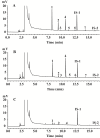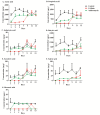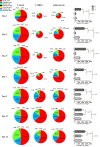Sensitive and Simplified Detection of Antibiotic Influence on the Dynamic and Versatile Changes of Fecal Short-Chain Fatty Acids
- PMID: 27907030
- PMCID: PMC5132400
- DOI: 10.1371/journal.pone.0167032
Sensitive and Simplified Detection of Antibiotic Influence on the Dynamic and Versatile Changes of Fecal Short-Chain Fatty Acids
Abstract
Short-chain fatty acids (SCFAs), produced by anaerobic fermentation of mainly indigestible dietary carbohydrates by gut microbiota, have a profound influence on intestinal function and host energy metabolism. Antibiotics may seriously disturb the balance of fecal SCFAs. To evaluate the impacts of antibiotics on fecal SCFAs produced by gut microbiota, a simple, reproducible and accurate gas chromatography (GC) method, which can simultaneously analyze seven SCFAs in fecal samples, was developed and validated. The ranges of detection and quantitation of the SCFAs reached 0.0868 ~ 0.393 and 0.261 ~ 1.18 μg·mL-1 respectively, in an optimized protocol for SCFAs extraction and analysis that used 10 mL 75% ethanol aqueous solution containing 1% HCl, without ultrasonication. The technique exhibited excellent intra-day (relative standard deviation (RSD) ≤ 2.54%) and inter-day (RSD ≤ 4.33%) precisions for all the SCFAs. Later, we administered broad-spectrum antibiotics, cefdinir or azithromycin to rats and analyzed the alterations in fecal SCFAs. The total amount, types and distribution of nearly all fecal SCFAs were significantly altered during the administration and even after withdrawal of the antibiotics in rats. The effects of cefdinir on the SCFAs were more pronounced than those of azithromycin. Our findings suggest SCFAs may serve as sensitive indicators to monitor the influences of antibiotics on SCFAs originated by intestinal bacteria. Our improved SCFAs analysis method is a potential platform for a standard clinical test of the effects of new antibiotics on SCFAs.
Conflict of interest statement
The authors have declared that no competing interests exist.
Figures






References
-
- Sako T, Matsumoto K, Tanaka R (1999) Recent progress on research and applications of non-digestible galacto-oligosaccharides. International Dairy Journal 9: 69–80.
-
- Rasmussen HS, Holtug K, Mortensen PB (1988) Degradation of amino acids to short-chain fatty acids in humans. An in vitro study. Scand J Gastroenterol 23: 178–182. - PubMed
MeSH terms
Substances
LinkOut - more resources
Full Text Sources
Other Literature Sources
Medical
Miscellaneous

